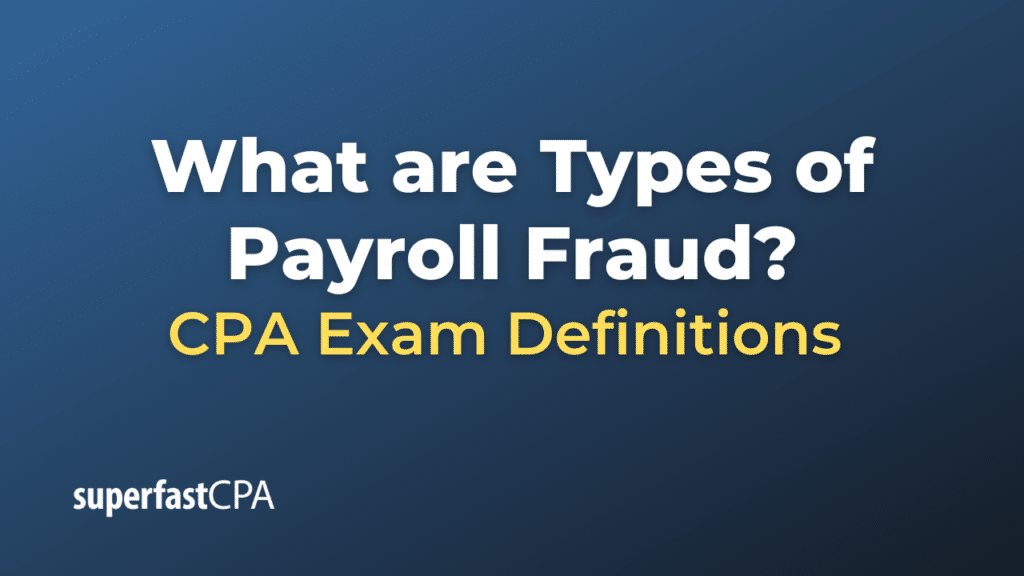Types of Payroll Fraud
Payroll fraud is a type of scheme in which employees, or sometimes employers, exploit the payroll system in a company to illegitimately receive funds. It’s one of the most common types of internal fraud affecting businesses. Here are some of the main types of payroll fraud:
- Ghost Employees:
- This involves someone on the payroll who doesn’t actually work for the company. Someone with access to the payroll system might add a non-existent person and then collect their pay.
- Example: A payroll clerk creates a fake employee profile and routes the paycheck to a personal account.
- Buddy Punching:
- An employee clocks in or out for another employee who isn’t present.
- Example: Joe uses Bob’s time card or login details to clock in for Bob when Bob isn’t actually at work.
- Excessive Overtime:
- An employee claims overtime for hours not actually worked.
- Example: Mary, a manager, consistently approves and reports 10 hours of overtime each week for herself, even though she doesn’t work those extra hours.
- Commission Schemes:
- Employees artificially boost sales or commissions figures to receive higher pay.
- Example: A salesperson manipulates the sales recording system to show higher sales numbers, thus earning a higher commission.
- Rate Tampering:
- False Expense Reimbursements:
- Employees submit fake or inflated expense reports to receive reimbursement for expenses they didn’t incur.
- Example: Karen goes on a business trip and submits a meal receipt for $200 when she actually spent $50.
- Advance Frauds:
- Workers’ Compensation Fraud:
- Employees fake or exaggerate injuries to receive workers’ compensation payments.
- Example: Alex claims he hurt his back at work and can’t work for three months. However, a coworker sees him playing basketball during this time.
- Withholding Manipulations:
- Altering the amount of tax or other withholdings to receive larger paychecks.
- Example: Lisa, who manages payroll, decreases the amount of tax withheld from her paycheck, resulting in a higher take-home pay but a larger tax bill later on.
To prevent payroll fraud, companies need to implement stringent internal controls, conduct regular audits, and promote a culture of honesty and accountability.
Example of Types of Payroll Fraud
Let’s delve deeper into a couple of the payroll fraud types mentioned above with more detailed scenarios:
- Ghost Employees:
- Scenario: At a large corporation, the head of the HR department, Mr. Jenkins, has been adding fictitious employees to the payroll system. These “employees” have names, social security numbers, job titles, and even consistent salaries. However, they don’t exist in real life. Every month, Mr. Jenkins diverts the salaries of these ghost employees to a bank account he controls. This fraudulent scheme goes undetected for years because Mr. Jenkins also creates fake performance reviews and other documentation for these ghost employees, making it seem as if they are real, contributing members of the company. The fraud is only uncovered when an external audit reveals discrepancies in employee counts between departments.
- False Expense Reimbursements:
- Scenario: Emily works as a sales representative and frequently travels to meet clients. She has developed a habit of inflating her travel expenses. For instance, if she dines alone, she’ll ask for a separate receipt and claim she had a meal with a potential client. She also submits taxi receipts for trips she didn’t take and occasionally adds a zero to hotel bills (turning a $100 bill into a $1000 claim). Over time, these inflated expenses add up. Her scheme is finally detected when the finance department starts using an advanced expense management software that flags anomalies in expense claims. A closer inspection of Emily’s claims reveals consistent discrepancies between her reports and actual incurred expenses.
Both scenarios showcase how, without proper checks and controls, payroll fraud can go undetected, costing companies significant amounts of money. Regular audits, both internal and external, as well as the use of advanced management software, can be instrumental in detecting and preventing such fraudulent activities.













